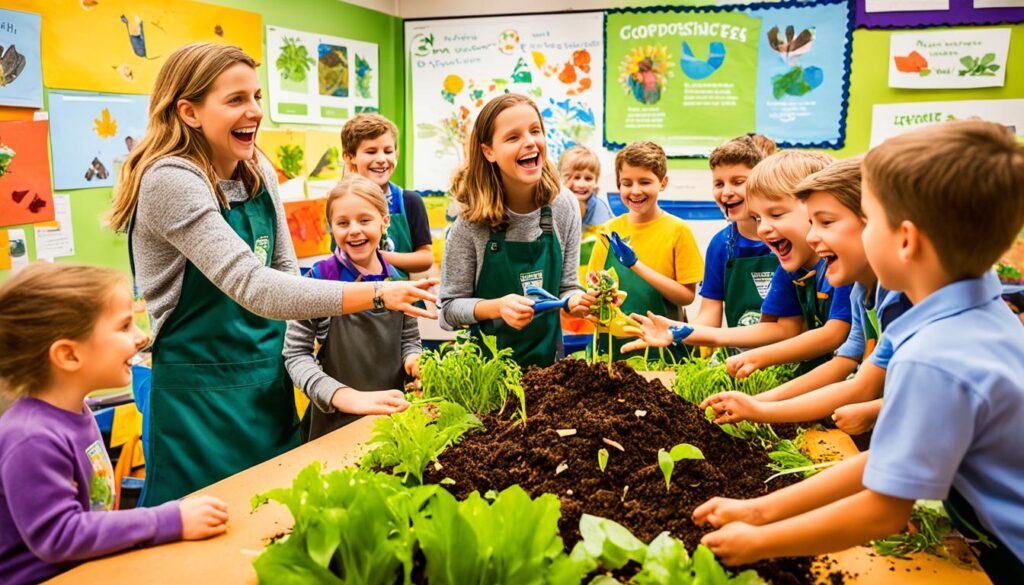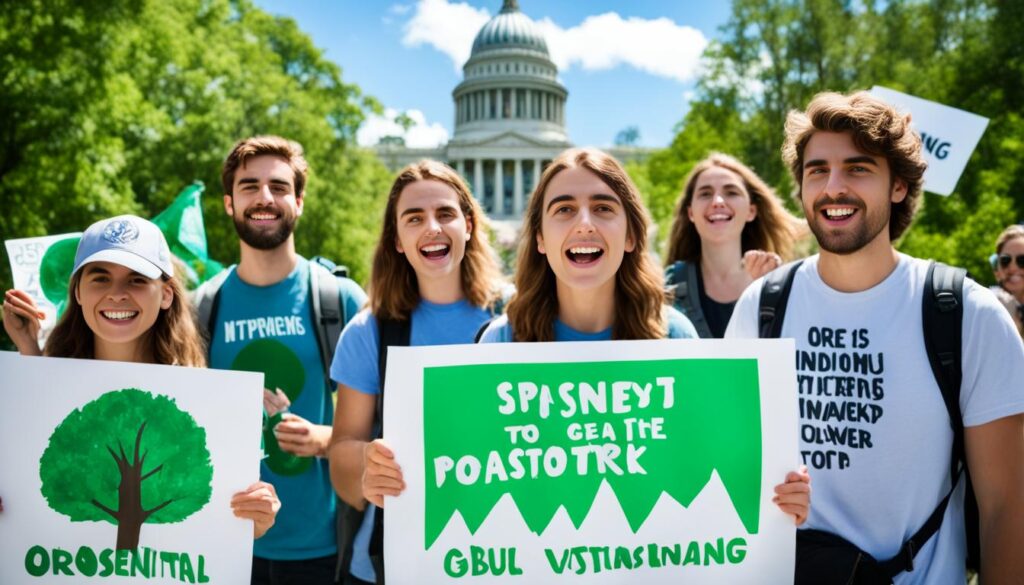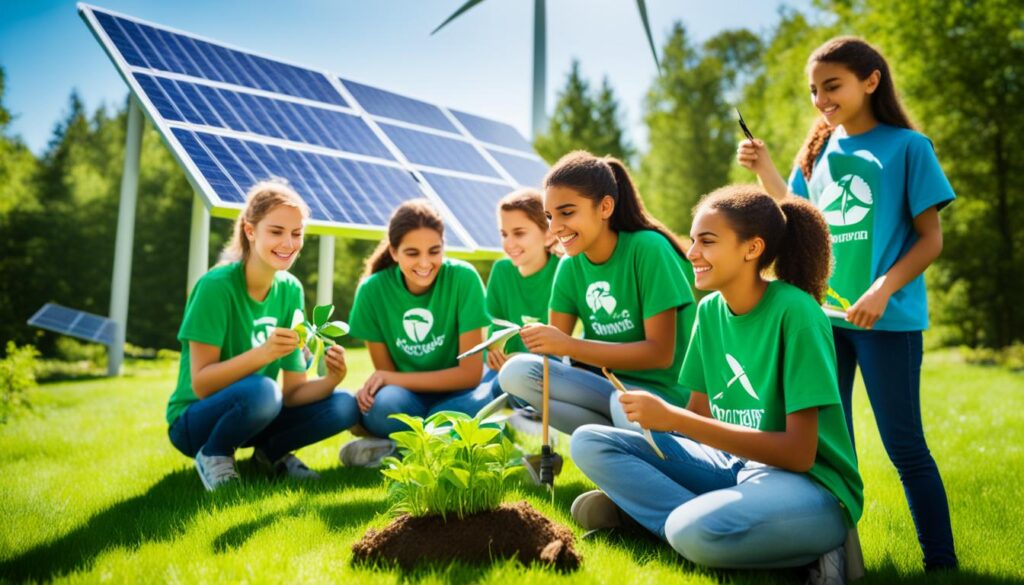Are you passionate about protecting the environment? Do you want to make a difference and create a sustainable future? You’re not alone. Young environmental advocates like you are the driving force behind positive change. Through education for sustainability, we can foster environmental awareness and empower young individuals to become champions for the planet.
Education is key to nurturing a love for nature and instilling a sense of responsibility towards the environment. By equipping young minds with the knowledge and tools to understand environmental issues, we empower them to take meaningful action. Together, we can build a generation of environmentally-conscious individuals who will shape the future of our planet.
Key Takeaways:
- Education is crucial for fostering environmental awareness and inspiring young individuals to become advocates.
- By instilling a sense of responsibility and providing knowledge about environmental issues, we empower young people to make a positive impact.
- Education for sustainability nurtures a love for nature and encourages environmentally-friendly behaviors.
- Young environmental advocates hold the key to a sustainable future and can drive positive change in their communities.
- Through education, we can create a generation that prioritizes environmental conservation and cares for the planet.
The Imperative Role of Environmental Awareness Education
Environmental awareness education plays a vital role in shaping the mindset and behaviors of young individuals. It provides them with the necessary knowledge and skills to understand the impact of human actions on the environment. By fostering a sense of responsibility, environmental education empowers young people to actively contribute to environmental conservation.
Through environmental awareness education, young individuals gain a deeper understanding of the interconnectedness between humans and the natural world. They learn about the importance of sustainable practices in mitigating environmental degradation and preserving the Earth’s resources for future generations.
One of the key benefits of environmental education is its ability to inspire and cultivate a love for the environment. By immersing young individuals in nature and teaching them about the beauty and value of the natural world, environmental education helps create a sense of awe and appreciation. This emotional connection motivates young people to take action and become stewards of the planet.
Moreover, environmental education equips young individuals with critical thinking and problem-solving skills. It challenges them to analyze complex environmental issues, evaluate different perspectives, and develop innovative solutions. These skills are invaluable in addressing the environmental challenges we face today and finding sustainable solutions for a better future.
In conclusion, the role of environmental awareness education cannot be overstated. It plays a pivotal role in shaping the mindset, behaviors, and actions of young individuals. By instilling a sense of responsibility, fostering a love for the environment, and equipping them with the necessary knowledge and skills, environmental education empowers the next generation to actively contribute to environmental conservation and create a sustainable future.
Methods to Instill Sustainable Behaviors in Children
Teaching sustainability to children and instilling eco-friendly behaviors are essential for creating a greener future. There are various effective methods that can help cultivate sustainable practices in kids.
One approach is to start with STEM education, which provides a gateway to green practices by teaching children about environmental issues through science, technology, engineering, and mathematics. By incorporating hands-on activities and real-life examples, children can develop a deeper understanding of the impact of their actions on the environment.

“STEM education allows children to not only learn about the environment but also encourages critical thinking and problem-solving skills,” says Emma Thompson, an environmental science teacher. “By engaging them in hands-on projects and experiments, they can understand how their actions can contribute to creating a sustainable future.”
Gardening and promoting environmental responsibility are also effective ways to instill sustainable behaviors in children. By involving kids in activities such as growing their own food, composting, and recycling, they can learn firsthand about sustainable food production and the importance of caring for the environment. It also fosters a sense of connection to nature and appreciation for the resources it provides.
Another method is to combat excessive screen time by encouraging environmental engagement. Encouraging children to spend more time outdoors and participate in activities like nature walks, bird watching, or beach clean-ups helps develop their love for the environment and promotes environmental awareness. It also allows them to witness the direct impact of their actions on the natural world.
By employing these methods, parents, teachers, and caregivers can play a crucial role in teaching sustainability to children and fostering eco-friendly behaviors. Through education and hands-on experiences, we can empower the next generation to become conscious global citizens who actively contribute to creating a sustainable future.
Real-World Applications for Young Advocates
Real-world applications provide young advocates with practical experiences and opportunities to make a difference. Engaging in community projects, participating in environmental clean-ups, and implementing sustainable practices in their daily lives allow them to see the tangible impact of their actions. These hands-on experiences not only reinforce their passion for environmental conservation but also empower them to create positive change in their communities.
To further illustrate the practical applications of environmental awareness, let’s explore some examples:
- Community Projects: Young advocates can get involved in community-driven projects such as establishing community gardens, organizing recycling initiatives, or promoting eco-friendly transportation options. These initiatives demonstrate how small actions can contribute to larger environmental goals and foster a sense of ownership in their local communities.
- Environmental Clean-ups: Participating in environmental clean-ups, whether on beaches, parks, or rivers, allows young advocates to witness firsthand the impact of pollution on the environment. By actively working to restore and preserve natural spaces, they develop a deeper appreciation for the importance of environmental conservation.
- Sustainable Practices: Implementing sustainable practices in their daily lives, such as reducing energy consumption, practicing responsible waste management, and adopting eco-friendly habits, helps young advocates integrate environmental awareness into their routines. These practices not only reduce their ecological footprint but also inspire others to follow suit.
- Engagement with Local Organizations: Partnering with local environmental organizations provides young advocates with opportunities to collaborate on projects and campaigns that address specific environmental issues. This engagement allows them to gain valuable insights, network with like-minded individuals, and contribute to meaningful change in their communities.
“Engaging in real-world applications not only broadens the understanding of environmental issues but also ignites the passion to take action.” – Jane Miller, Environmental Educator
By actively participating in these practical applications and experiences, young advocates deepen their understanding of environmental issues and cultivate skills necessary for effective environmental advocacy. They learn the importance of collaboration, problem-solving, and leadership, setting a solid foundation for their future endeavors.
Now, let’s continue exploring how environmental education can open doors to eco-friendly careers and empower young individuals to create a sustainable future.
Tapping into the Potential of Eco-Friendly Careers
Introducing youth to green professions opens up a world of possibilities for them to pursue meaningful careers that align with their passion for the environment. By exploring sustainable career options, young individuals can contribute to creating a more sustainable future while also finding personal fulfillment in their work.
“Choose a job you love, and you will never have to work a day in your life.” – Confucius
Through mentorship and professional exposure, young individuals can connect with professionals in various environmental fields and gain valuable insights into different career paths. This guidance allows them to make informed decisions about their future and understand how their skills and interests can make a positive impact on the planet.
Sustainable education plays a crucial role in career planning by equipping young individuals with the necessary knowledge and skills required for a successful career in environmental conservation. By pursuing academic programs and training opportunities that focus on sustainability, they can develop a strong foundation in environmental science, resource management, renewable energy, and other relevant areas of expertise.
Dedicated environmental education programs also provide hands-on learning experiences, allowing students to apply their knowledge and skills in real-world settings. These practical experiences help them develop problem-solving abilities, critical thinking skills, and an understanding of the complexities involved in sustainable practices.
Moreover, with the increasing global demand for sustainable practices and green initiatives, the job market for environmentally conscious professionals is expanding. Green professions span various sectors, including renewable energy, green building and design, environmental consulting, sustainable agriculture, and conservation. This diverse range of career options provides ample opportunities for individuals to find their niche and contribute to a greener and more sustainable world.
| Green Professions | Description |
|---|---|
| Renewable Energy Specialist | Design and implement alternative energy systems such as solar, wind, and geothermal. |
| Sustainability Consultant | Advise organizations on sustainable practices, environmental regulations, and resource optimization. |
| Environmental Engineer | Develop and implement solutions to minimize the harmful impact of human activities on the environment. |
| Conservation Biologist | Study and protect endangered species and ecosystems to ensure their long-term survival. |
By pursuing a career in a green profession, individuals can not only contribute to preserving the environment but also enjoy job stability and growth in a rapidly evolving sector. They become agents of change, driving sustainable practices, developing innovative solutions, and influencing organizations to adopt environmentally responsible strategies.
The field of eco-friendly careers offers exciting opportunities for personal and professional growth. Through continuous learning, networking, and staying up-to-date with the latest advancements, young individuals can thrive in their chosen green professions and play a significant role in creating a more sustainable and environmentally conscious society.
International Youth Movements and Climate Activism
International youth movements and climate activism have gained significant momentum in recent years. Young individuals from around the world have come together to raise their voices and fight against the pressing issue of climate change. Their efforts have helped shed light on the global perspectives on climate change, highlighting its impacts on communities and ecosystems across continents. These youth climate activists play a pivotal role in advocating for collective action to address environmental challenges and create a sustainable future.
One prominent example of youth climate activism is the Fridays for Future movement, inspired by Greta Thunberg. This movement originated with Thunberg’s solo school strike for climate action, which quickly grew into a global phenomenon. Young activists organize strikes and protests on Fridays to demand action from governments and raise awareness about the urgent need to combat climate change. They have become powerful agents of change, utilizing social media platforms and organizing grassroots campaigns to mobilize communities and drive discussions on climate justice.

This image showcases the passionate commitment of youth climate activists. It symbolizes their determination, unity, and resilience as they work towards a sustainable future for all.
Through their tireless advocacy, these young activists demonstrate the power of collective action in addressing climate change. They inspire individuals of all ages to recognize their responsibility and take meaningful steps towards protecting the environment. Their commitment to fostering global perspectives on climate change and their unwavering dedication to the collective action for the environment serve as a beacon of hope for the future.
Education as a Catalyst for Environmental Change
Education plays a crucial role in driving environmental change. By incorporating sustainability into school curriculums, we can provide students with the knowledge and tools to make informed decisions and adopt sustainable practices. It also fosters a sense of responsibility and empowers them to become lifelong environmental advocates. In addition, education helps shape behaviors and attitudes towards the environment, creating a generation that prioritizes sustainability.
Through education, students gain a deep understanding of the interconnectedness between human activities and the natural world. They learn about the impact of pollution, deforestation, and climate change, and how their choices can contribute to positive change. By promoting education for sustainability, we equip them with the skills needed to address pressing environmental challenges.

Furthermore, education influences behavior change. When students are educated about the importance of sustainable practices, they are more likely to adopt environmentally friendly behaviors. They become conscious of their consumption habits, reducing waste and conserving resources. Education also encourages them to spread awareness and promote sustainable practices among their peers and communities.
Education for sustainability provides individuals with the tools and knowledge to actively participate in environmental conservation. By nurturing an environmentally conscious mindset, education ensures that the next generation becomes stewards of the planet, working towards a sustainable future for all.
Incorporating Sustainable Education into School Curriculums
Developing environmental education programs and integrating them into school curriculums is essential for promoting environmental awareness. By incorporating engaging educational practices and showcasing successful case studies, we can effectively educate students about the importance of environmental conservation.
Engaging Educational Practices:
- Hands-on Activities: Encourage students to actively participate in hands-on activities, such as building eco-friendly models or creating sustainable art projects. These activities help students understand environmental concepts in a practical and fun way.
- Field Trips: Take students on field trips to local parks, nature reserves, or environmental organizations. Experiencing nature firsthand and interacting with environmental experts can spark a sense of curiosity and appreciation for the natural world.
- Interactive Learning: Utilize technology and interactive tools to enhance the learning experience. Incorporate educational apps, online simulations, and interactive exercises that allow students to explore environmental concepts in an engaging and interactive way.
Successful Case Studies:
“The Environmental Education Program at Greenleaf Elementary School saw a significant increase in students’ environmental awareness and sustainable behaviors. By integrating environmental lessons across various subjects and allowing students to take on environmental projects, the school successfully instilled a love for the environment in their students.”
“The Sustainable Schools Initiative in partnership with the local community resulted in improved sustainability practices among students. Through the integration of sustainable practices in the curriculum and the establishment of eco-clubs, students actively participated in initiatives such as waste reduction, recycling, and energy conservation.”
By implementing these engaging practices and showcasing successful case studies, we can inspire the next generation to become environmentally conscious citizens and make a positive impact on the world around them.
Strategies for Promoting Environmental Awareness in Communities
Promoting environmental awareness in communities requires active participation from individuals and leveraging technology and media. By encouraging community involvement in environmental initiatives such as clean-ups and tree plantings, we can foster a sense of collective responsibility and encourage sustainable practices.
One effective strategy is to organize community clean-up events, where community members come together to remove litter and debris from public spaces. This not only improves the local environment but also creates a sense of pride and ownership among community members. By actively participating in clean-up activities, individuals become more aware of the impact of their actions on the environment and are more likely to adopt sustainable practices in their daily lives.
Another strategy is to organize tree planting initiatives, where community members work together to plant trees in parks, schools, and other open spaces. Tree planting not only helps beautify the community but also provides numerous environmental benefits such as reducing air pollution, conserving energy, and mitigating the effects of climate change. By involving the community in such initiatives, we can create a strong sense of environmental stewardship and inspire individuals to take action to protect and preserve the natural world.
Technology and media platforms also play a crucial role in promoting environmental awareness. Leveraging social media, websites, and mobile applications, we can educate and raise awareness about climate change and environmental issues. Sharing informative articles, engaging videos, and interactive quizzes can help reach a wider audience and encourage them to learn more about the importance of environmental conservation.
In addition, technology can be used to facilitate climate literacy among community members. Online courses, webinars, and virtual workshops can provide accessible and interactive educational opportunities for individuals of all ages. By leveraging technology for climate literacy, we can empower community members with the knowledge and skills to make informed decisions and take action to protect the environment.
By combining community participation in environmental initiatives with the power of technology and media, we can create a widespread movement of environmental awareness and action. Together, we can foster a sustainable future for our communities and the planet.
Conclusion
In conclusion, environmental awareness education is essential for empowering the next generation to become environmental advocates. By instilling sustainable behaviors, providing real-world applications, and exploring eco-friendly career options, we can create a generation that is passionate about and actively involved in environmental conservation.
Through education, we can foster a sense of responsibility and inspire individuals to take action. By equipping young minds with the knowledge and tools to understand and address environmental issues, we can ensure a sustainable future for our planet and future generations.
By encouraging a love for nature and promoting sustainable practices, we enable young individuals to make a positive impact on the planet. It is through their actions and collective efforts that we can create a world where environmental stewardship is a shared value.
Environmental awareness education is not just a pathway to knowledge, but a catalyst for change. By empowering the next generation, we are building a sustainable future where the protection and preservation of our environment are at the forefront of societal values.
FAQ
Why is environmental awareness education important?
Environmental awareness education is crucial for instilling a sense of responsibility and inspiring young individuals to take action in creating a sustainable future. It equips them with the knowledge and tools to understand environmental issues and promotes a love for nature, empowering them to make a positive impact on the planet.
What role does environmental awareness education play?
Environmental awareness education shapes the mindset and behaviors of young individuals, helping them understand the impact of human actions on the environment, fostering a sense of responsibility, and promoting sustainable practices. It empowers them to become stewards of the planet and actively contribute to environmental conservation.
How can sustainable behaviors be instilled in children?
Sustainable behaviors can be instilled in children through various methods. Starting with STEM education, which incorporates environmental issues into science, technology, engineering, and mathematics, provides a gateway to understanding green practices. Additionally, gardening and environmental responsibility allow children to learn firsthand about sustainable food production and the importance of caring for the environment. Combating screen time with environmental engagement encourages children to spend more time outdoors and participate in activities that promote environmental awareness.
What are some real-world applications for young environmental advocates?
Young environmental advocates can engage in community projects, participate in environmental clean-ups, and implement sustainable practices in their daily lives. These experiences provide practical opportunities for them to see the tangible impact of their actions, reinforce their passion for environmental conservation, and empower them to create positive change in their communities.
How can eco-friendly careers be explored by young individuals?
Young individuals can explore eco-friendly careers by connecting with professionals in various environmental fields through mentorship and professional exposure. This allows them to gain valuable insights into different career paths and understand the knowledge and skills required for a successful career in environmental conservation.
What is the significance of international youth movements and climate activism?
International youth movements and climate activism provide global perspectives on the impacts of climate change and highlight the efforts made by young eco-warriors from different countries. These movements, such as the Fridays for Future inspired by Greta Thunberg, showcase the spirit of collective action and the power of young voices in advocating for climate justice.
How does education contribute to environmental change?
Education plays a crucial role in driving environmental change by incorporating sustainability into school curriculums. It provides students with the knowledge and tools to make informed decisions and adopt sustainable practices. Education also shapes behaviors and attitudes towards the environment, creating a generation that prioritizes sustainability.
How can sustainable education be integrated into school curriculums?
Sustainable education can be integrated into school curriculums through the development of environmental education programs. These programs can incorporate engaging educational practices such as hands-on activities, field trips, and interactive learning to enhance the learning experience and ensure active participation from students. Successful case studies demonstrate the effectiveness of these programs in engaging students and fostering a love for the environment.
What strategies can be used to promote environmental awareness in communities?
Promoting environmental awareness in communities requires active participation from individuals and leveraging technology and media. Encouraging community involvement in environmental initiatives, such as clean-ups and tree plantings, fosters a sense of collective responsibility and encourages sustainable practices. Technology and media platforms provide opportunities to educate and raise awareness about climate change, reaching a wider audience and promoting climate literacy.
What is the overall importance of environmental awareness education?
Environmental awareness education is crucial for empowering the next generation to become environmental advocates. It instills sustainable behaviors, provides real-world applications, explores eco-friendly career options, and fosters a sense of responsibility. By educating young individuals, we can create a generation that is passionate about and actively involved in environmental conservation, ensuring a sustainable future for our planet and future generations.
Source Links
- https://www.unicef.org/stories/young-climate-activists-demand-action-inspire-hope
- https://www.fizzicseducation.com.au/articles/inspiring-children-to-be-advocates-for-sustainability/
- https://www.globalschoolsprogram.org/post/global-schools-advocates-share-the-importance-of-using-education-to-protect-the-earth

